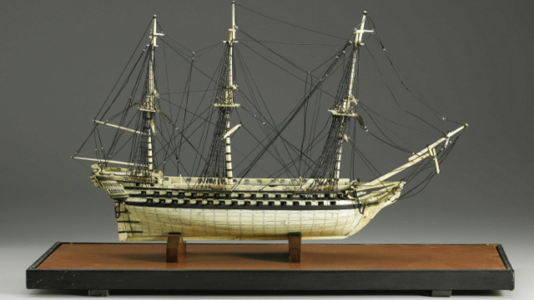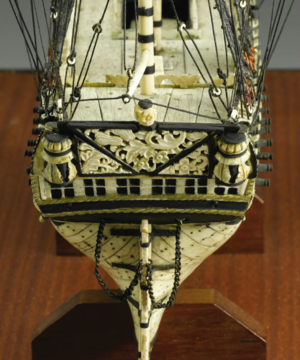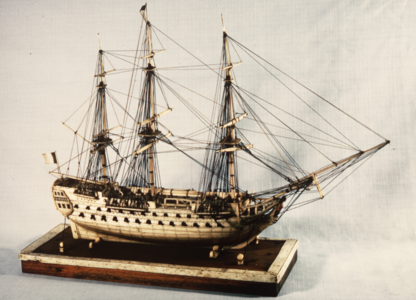* Some information is taken from Fine Scale Modeler
On different threads, from time to time, I am seeing an ambiguous term 'Museum quality model', I cannot justify it. The simple answer is this: Any model that a museum wants to display is "museum quality". There is no set construction standard and people who use this term are probably doing so in an effort to 1) boost their ego or 2) get more money for a model they are selling!
Museums have lots of reasons for acquiring models - and only some of those reasons have anything to do with "quality" as a model builder would define the term. Normally large museums do not commission models, you find that mostly with very small museums on military bases. They have very tight budgets and you're not going to make as much as you will from a private collector. Smithsonian and the US Navy do have guidelines for materials and the bottom line is the materials for new builds MUST have a proven record of lasting a minimum of 100 years without degradation and without causing other materials to degrade as well. Some of the models at the USNA museum are close to 400 years old. "Museum quality" as regards the detail level and accuracy is in fact a misnomer. A much better term, IMHO, is "competition grade" where a model stands a very good chance of winning in seriously judged competition... but even this is subjective: Who are the judges?
The ship models that prisoners of war carved out of bone during the Napoleonic Wars belong to what category? The hull lines of such a model are likely to be way out of proportion. (The builder had no plans to work from, and he never saw the underwater hull of the ship.) It's probably made out of soup bones and rigged with human hair. It doesn't really meet any definition of the term "scale model." But nobody who's ever looked at a POW model is likely to deny that a museum is the right place for such models.
Some of the finest models I've ever seen have been built by masters\commissioners, and some of the finest models I've ever seen have been built by amateurs\hobbyists. The term "Museum Quality" does, of course, have some practical implications (in the eyes, for instance, of the seller\builder). But in terms of the quality\grade of the model, it has no meaning whatsoever.
One thing is certain... Some of the models on display in the museum should not win any award (except perhaps a public's favorite award) at a typical modeling competition. Those models on display have seam lines, glue marks, poor finishes, asymmetrical components, minimal extras, and a general lack of detail seen on "competition grade\quality" models.
I trust this information will stimulate debate, and if anyone has any queries, please post a reply.
On different threads, from time to time, I am seeing an ambiguous term 'Museum quality model', I cannot justify it. The simple answer is this: Any model that a museum wants to display is "museum quality". There is no set construction standard and people who use this term are probably doing so in an effort to 1) boost their ego or 2) get more money for a model they are selling!
Museums have lots of reasons for acquiring models - and only some of those reasons have anything to do with "quality" as a model builder would define the term. Normally large museums do not commission models, you find that mostly with very small museums on military bases. They have very tight budgets and you're not going to make as much as you will from a private collector. Smithsonian and the US Navy do have guidelines for materials and the bottom line is the materials for new builds MUST have a proven record of lasting a minimum of 100 years without degradation and without causing other materials to degrade as well. Some of the models at the USNA museum are close to 400 years old. "Museum quality" as regards the detail level and accuracy is in fact a misnomer. A much better term, IMHO, is "competition grade" where a model stands a very good chance of winning in seriously judged competition... but even this is subjective: Who are the judges?
The ship models that prisoners of war carved out of bone during the Napoleonic Wars belong to what category? The hull lines of such a model are likely to be way out of proportion. (The builder had no plans to work from, and he never saw the underwater hull of the ship.) It's probably made out of soup bones and rigged with human hair. It doesn't really meet any definition of the term "scale model." But nobody who's ever looked at a POW model is likely to deny that a museum is the right place for such models.
Some of the finest models I've ever seen have been built by masters\commissioners, and some of the finest models I've ever seen have been built by amateurs\hobbyists. The term "Museum Quality" does, of course, have some practical implications (in the eyes, for instance, of the seller\builder). But in terms of the quality\grade of the model, it has no meaning whatsoever.
One thing is certain... Some of the models on display in the museum should not win any award (except perhaps a public's favorite award) at a typical modeling competition. Those models on display have seam lines, glue marks, poor finishes, asymmetrical components, minimal extras, and a general lack of detail seen on "competition grade\quality" models.
I trust this information will stimulate debate, and if anyone has any queries, please post a reply.









